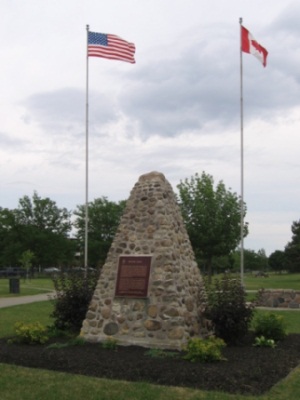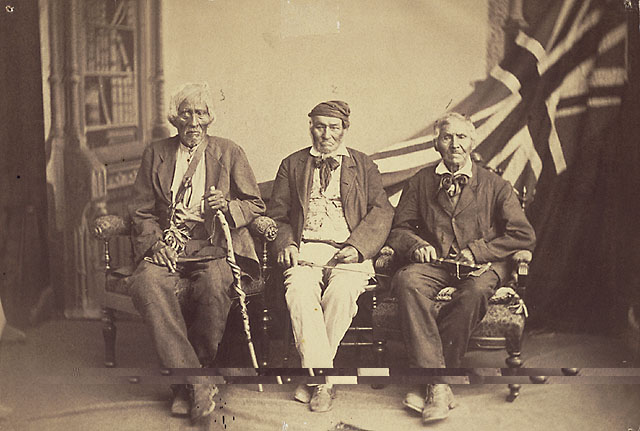The Battle of Beaver Dams took place during the War of 1812. On 24 June 1813, American troops marched from Fort George and intended to surprise the British at Beaver Dams. Laura Secord, a woman living in Queenston where the Americans had temporarily lodged, learned about this plan, and set off on a journey to warn the British. When the Americans resumed their trek to Beaver Dams, they were ambushed by Kanyen'kehà:ka (Mohawk) and other Indigenous warriors. The Americans lost the battle, surrendering to British troops led by Lieutenant James FitzGibbon (also spelled Fitzgibbon). The Battle of Beaver Dams established the importance of professional soldiering, Indigenous warfare and luck involved in British victory.
Background
The Battle of Beaver Dams occurred during the "see-saw" battles of 1813, in which American forces sought to press their victories on Canadian soil after the successful capture of Fort George in May 1813. On 24 June 1813, almost 500 American troops under Lieutenant-Colonel Charles G. Boerstler were sent from Fort George to harass and encounter Brigadier General Vincent's advanced post near Beaver Dams. Stationed there was one company of the 49th Foot, under the command of Lieutenant James FitzGibbon. However, a late start and loose talk among Boerstler's men sowed the seeds of Boerstler's defeat.

Laura Secord Warns James FitzGibbon
Laura Secord, a Queenston housewife whose husband had been injured during the Battle of Queenston Heights, overheard talk regarding the upcoming American attack. With her husband ailing, Secord trekked over 30 km toward Beaver Dams to warn the British troops, allegedly passing through American lines and at great risk to her safety, until she encountered an Indigenous camp where she found a guide to lead her the rest of the way. Secord warned FitzGibbon, but since she had no specifics on the advancing US forces, FitzGibbon waited for more information. On the 24th, Indigenous scouts reported the American advance to Captain Dominique Ducharme of the Indian Department. He sent word to FitzGibbon, and the ambush was on. To his great regret, Boerstler was aware that Indigenous people had spotted him, but pressed on with his advance.
The Battle of Beaver Dams
A party of 300 Kanyen'kehà:ka (Mohawk) warriors from Kahnawake attacked the Americans from the rear along an enclosed, wooded section of the trail near Beaver Dams (now Thorold, Ontario). They were soon joined by 100 more Kanyen'kehà:ka warriors led by Captain William Kerr. After three hours of firing at shadows, the American forces were ready to surrender, but feared what Indigenous soldiers might do to them as prisoners. FitzGibbon arrived with 50 soldiers of his own 49th Regiment.
According to FitzGibbon, he was able to begin the process of surrender in part because of the terror the Indigenous soldiers had instilled in the Americans. He had also persuaded Boerstler that his own force of fewer than 50 regulars was simply the vanguard of a larger British contingent lurking behind the trees and that, if the fighting continued, it might be impossible to control the ferocity of the warriors. Still, it was only when Major P. W. De Haren of the 104th Regiment arrived with large reinforcements that a surrender was formally reached, and by De Haren himself.
When the dust settled, five Indigenous chiefs and warriors were said to have been killed, and 20-25 wounded. The Americans suffered 25 dead and 50 injured, including the commander, Boerstler.

Aftermath
Kanyen'kehà:ka leader John Norton, who had fought at Beaver Dams, claimed that while Indigenous soldiers fought the battle, FitzGibbon got the credit. However, FitzGibbon noted that the credit that was his due was in seizing an opportunity for using fear, not bullets, rooted in the successful guerilla tactics of the Indigenous forces.
Along with their defeat at Stoney Creek three weeks earlier, the Battle of Beaver Dams left the Americans convinced that they could not safely venture from the protected confines of Fort George, and it led directly to the dismissal of the ailing Major General Henry Dearborn, commander of US forces in Upper Canada, by US Secretary of War John Armstrong.
Controversy remains over how much credit for victory should be given to the Indigenous or British leadership. Additionally, the details of Laura Secord's efforts to reach FitzGibbon and sound the alarm are uncertain, but have been made part of Canadian mythology and employed to foster Canadian nationalism.

 Share on Facebook
Share on Facebook Share on X
Share on X Share by Email
Share by Email Share on Google Classroom
Share on Google Classroom










